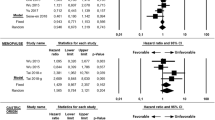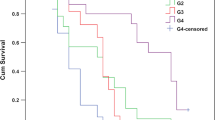Abstract
Background
Malignant peritoneal mesothelioma (MPM) is a rare and fatal cancer. Females are found to survive longer than males after treatment, suggesting a possible involvement of hormonal factors. Estradiol is involved in cellular proliferation of a number of cancers and acts mainly through oestrogen receptors (ERs). Hence, we examined the expression of oestrogen receptors with correlation to prognosis.
Methods
Oestrogen receptors expression was examined using immunohistochemistry on 42 paraffin-embedded sections of MPM tumours. Kaplan–Meier survival curves were analysed to determine the significance of ER expression in relation to prognosis.
Results
ER-β (nuclear) was detected in 33 (79 %) patients. ER-β was also detected in the cellular cytoplasm of 9 (21 %) patients. Presence of ER-β (nuclear) was associated with favourable survival (univariate analysis, P = 0.001), whereas the presence of ER-β (cytoplasm) was associated with a poor survival (P = 0.014). Multivariate Cox regression analysis revealed the absence of ER-β (nuclear) and the presence of ER-β (cytoplasm) to be independent predictive factors for poor disease outcome (hazard ratio 5.4, 95 % confidence interval 1.86–15.75; P = 0.002 and hazard ratio 8.0, 95 % confidence interval 1.8–34; P = 0.005), respectively. ER-α (nuclear) was detected in only 4 (9 %) of patients and not statistically significant (univariate analysis, P = 0.066).
Conclusion
The presence of ER-β (cytoplasm) is associated with poor prognosis. The favourable survival association observed in patients with ER-β (nuclear) raises a question about the molecular mechanisms of the tumorigenic roles of ER-β in each cellular compartment and requires further studies.



Similar content being viewed by others
References
Acherman YI, Welch LS, Bromley CM et al (2003) Clinical presentation of peritoneal mesothelioma. Tumori 89:269–273
Ahmed I, Koulaouzidis A, Iqbal J et al (2008) Malignant peritoneal mesothelioma as a rare cause of ascites: a case report. J Med Case Rep 2:121
Allred DC, Harvey JM, Berardo M et al (1998) Prognostic and predictive factors in breast cancer by immunohistochemical analysis. Mod Pathol 11:155–168
Antman K, Shemin R, Ryan L et al (1988) Malignant mesothelioma: prognostic variables in a registry of 180 patients, the Dana-Farber Cancer Institute and Brigham and Women’s Hospital experience over two decades, 1965–1985. J Clin Oncol 6:147–153
Baratti D, Kusamura S, Cabras AD et al (2010) Lymph node metastases in diffuse malignant peritoneal mesothelioma. Ann Surg Oncol 17:45–53
Bechis SK, Carroll PR, Cooperberg MR (2011) Impact of age at diagnosis on prostate cancer treatment and survival. J Clin Oncol 29:235–241
Boffetta P (2007) Epidemiology of peritoneal mesothelioma: a review. Ann Oncol 18:985–990
Cavallini A, Notarnicola M, Giannini R et al (2005) Oestrogen receptor-related receptor alpha (ERRalpha) and oestrogen receptors (ERalpha and ERbeta) exhibit different gene expression in human colorectal tumour progression. Eur J Cancer 41:1487–1494
Cheng J, Lee EJ, Madison LD et al (2004) Expression of estrogen receptor beta in prostate carcinoma cells inhibits invasion and proliferation and triggers apoptosis. FEBS Lett 566:169–172
Chua TC, Yan TD, Morris DL (2009) Outcomes of cytoreductive surgery and hyperthermic intraperitoneal chemotherapy for peritoneal mesothelioma: the Australian experience. J Surg Oncol 99:109–113
Deraco M, Nonaka D, Baratti D et al (2006) Prognostic analysis of clinicopathologic factors in 49 patients with diffuse malignant peritoneal mesothelioma treated with cytoreductive surgery and intraperitoneal hyperthermic perfusion. Ann Surg Oncol 13:229–237
Deraco M, Baratti D, Cabras AD et al (2010) Experience with peritoneal mesothelioma at the Milan National Cancer Institute. World J Gastrointest Oncol 2:76–84
Eltabbakh GH, Piver MS, Hempling RE et al (1999) Clinical picture, response to therapy, and survival of women with diffuse malignant peritoneal mesothelioma. J Surg Oncol 70:6–12
Harvey JM, Clark GM, Osborne CK et al (1999) Estrogen receptor status by immunohistochemistry is superior to the ligand-binding assay for predicting response to adjuvant endocrine therapy in breast cancer. J Clin Oncol 17:1474–1481
Hayashi SI, Eguchi H, Tanimoto K et al (2003) The expression and function of estrogen receptor alpha and beta in human breast cancer and its clinical application. Endocr Relat Cancer 10:193–202
Jassam N, Bell SM, Speirs V et al (2005) Loss of expression of oestrogen receptor beta in colon cancer and its association with Dukes’ staging. Oncol Rep 14:17–21
Kawai H, Ishii A, Washiya K et al (2005) Estrogen receptor alpha and beta are prognostic factors in non-small cell lung cancer. Clin Cancer Res 11:5084–5089
Kinoshita Y, Takasu K, Yuri T et al (2013) Two cases of malignant peritoneal mesothelioma without asbestos exposure: cytologic and immunohistochemical features. Ann Diagn Pathol 17:99–103
Lamont KR, Tindall DJ (2011) Minireview: alternative activation pathways for the androgen receptor in prostate cancer. Mol Endocrinol 25:897–907
Leung YK, Lam HM, Wu S et al (2010) Estrogen receptor beta2 and beta5 are associated with poor prognosis in prostate cancer, and promote cancer cell migration and invasion. Endocr Relat Cancer 17:675–689
Liu MM, Albanese C, Anderson CM et al (2002) Opposing action of estrogen receptors alpha and beta on cyclin D1 gene expression. J Biol Chem 277:24353–24360
Manzini Vde P, Recchia L, Cafferata M et al (2010) Malignant peritoneal mesothelioma: a multicenter study on 81 cases. Ann Oncol 21:348–353
Merrill RM, Bird JS (2002) Effect of young age on prostate cancer survival: a population-based assessment (United States). Cancer Causes Control 13:435–443
Neumann V, Muller KM, Fischer M (1999) Peritoneal mesothelioma–incidence and etiology. Pathologe 20:169–176
Niikawa H, Suzuki T, Miki Y et al (2008) Intratumoral estrogens and estrogen receptors in human non-small cell lung carcinoma. Clin Cancer Res 14:4417–4426
Peng B, Lu B, Leygue E et al (2003) Putative functional characteristics of human estrogen receptor-beta isoforms. J Mol Endocrinol 30:13–29
Pinton G, Brunelli E, Murer B et al (2009) Estrogen receptor-beta affects the prognosis of human malignant mesothelioma. Cancer Res 69:4598–4604
Robinson BW, Musk AW, Lake RA (2005) Malignant mesothelioma. Lancet 366:397–408
Sridhar KS, Doria R, Raub WA Jr et al (1992) New strategies are needed in diffuse malignant mesothelioma. Cancer 70:2969–2979
Sugarbaker PH (2009) Comprehensive management of peritoneal surface malignancy using cytoreductive surgery and perioperative intraperitoneal chemotherapy: the Washington Cancer Institute approach. Expert Opin Pharmacother 10:1965–1977
van Leeuwen BL, Pahlman L, Gunnarsson U et al (2008) The effect of age and gender on outcome after treatment for colon carcinoma. A population-based study in the Uppsala and Stockholm region. Crit Rev Oncol Hematol 67:229–236
Woo IS, Park MJ, Choi SW et al (2004) Loss of estrogen receptor-alpha expression is associated with hypermethylation near its ATG start codon in gastric cancer cell lines. Oncol Rep 11:617–622
Wu CT, Chang YL, Shih JY et al (2005) The significance of estrogen receptor beta in 301 surgically treated non-small cell lung cancers. J Thorac Cardiovasc Surg 130:979–986
Yan TD, Popa E, Brun EA et al (2006) Sex difference in diffuse malignant peritoneal mesothelioma. Br J Surg 93:1536–1542
Yan TD, Brun EA, Cerruto CA et al (2007) Prognostic indicators for patients undergoing cytoreductive surgery and perioperative intraperitoneal chemotherapy for diffuse malignant peritoneal mesothelioma. Ann Surg Oncol 14:41–49
Yonemura Y, Tsukiyama G, Miyata R et al (2010) Indication of peritonectomy for peritoneal dissemination. Gan To Kagaku Ryoho 37:2306–2311
Conflict of interest
None.
Author information
Authors and Affiliations
Corresponding author
Rights and permissions
About this article
Cite this article
Pillai, K., Pourgholami, M.H., Chua, T.C. et al. Oestrogen receptors are prognostic factors in malignant peritoneal mesothelioma. J Cancer Res Clin Oncol 139, 987–994 (2013). https://doi.org/10.1007/s00432-013-1408-2
Received:
Accepted:
Published:
Issue Date:
DOI: https://doi.org/10.1007/s00432-013-1408-2




